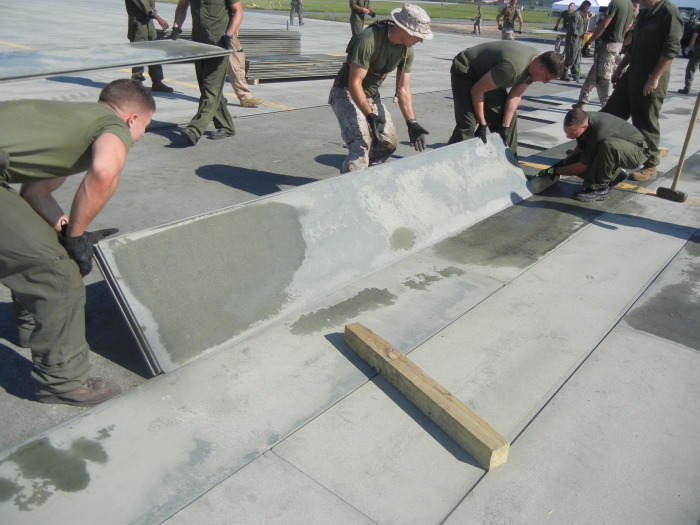Leading industrial 3D printer OEM EOS is helping Indiana Technology and Manufacturing Company (ITAMCO), an American machining technology and services company, to develop a new runway mat for the United States Air Force (USAF) using its 3D printing technology.
Runway mats form a critical component of the portable airfields, or Expeditionary Airfields (EAFs), used by the USAF for temporary or expeditionary flight operations. These are often made with an aluminum plank matting called AM-2, which has been used since the Vietnam war. The ITAMCO-led research project will update the 1960-era AM-2 mat with an alternative runway surface using EOS’ M290 3D printer and StainlessSteel 316L VPro metal powder. Significantly, the research project will make use of a unique material technology known as Phase Transforming Cellular Matrix (PXCM) as well, which will enable a longer lifespan for runways compared to those made with AM-2 matting.
Patrick Boyd, Marketing Director, EOS North America, states:
“We’re excited that ITAMCO has partnered with EOS in ITAMCO’s endeavors to create forward-thinking solutions. They are not afraid to engineer then employ extraordinary solutions where no solution previously existed.”

Self-healing PXCM material geometry
Founded in 1955, ITAMCO serves the mining, off-highway vehicles, marine, and aviation industries by providing them with open gearing and precision machining services and components. Scott Hartford, Project Manager at ITAMCO, is working on the runway mat project with Professor Pablo Zavattieri in the Lyles School of Civil Engineering at Purdue University.
EAFs are constructed, used, and broken down after a mission is completed, where it is then moved to another site to be reused. EAF mats are required to be easily installed, while also capable of withstanding repeated take-offs and landings from aircraft and the impact from arresting hooks. In order to create a robust runway mat to serve the USAF, Hartford and Zavattieri identified PXCM geometry, which they believe will help mitigate anticipated loading and shear stresses.
PXCM is a material geometry that grants parts and products the ability to alternate and phase between different stable configurations. The benefits of this process, according to an article by Nadia Aljabi in the Journal of Purdue Undergraduate Research, is that PCXM can absorb significant amounts of energy whilst remaining reusable. This is enabled by the phase transformation, which can be reversed without inducing permanent deformation into the base material. Therefore, PXCM will lend the runway mat ‘self-healing’ capabilities, enabling a longer lifespan compared to the AM-2.
The PXCM solution will be able to support flight operations of 5,000 landing and takeoff cycles over 60 days. It is targeted to weigh 3.5 lb. per sq. ft. or less, meaning members of the USAF will be able to lay the runway mat on level surfaces of the appropriate density by hand. Furthermore, the performance of the PXCM runway may will not be affected by debris on the runway itself.
Cutting costs with EOS
Prototypes of the PXCM mat will be manufactured using an EOS M290 3D printer employed by ITAMCO. The Stainless Steel 316L VPro was identified to create the PXCM runway mat prototypes as it will reportedly enable a reduced production time by 70 percent and lessen the cost by up to 50 percent when used with the EOS system. “EOS StainlessSteel 316L VPro is a highly productive material that was born from our collaborate development effort with GKN. Applications using 316L VPro, combined with highly proven EOS metal 3D printing technologies, result in accelerated production with lower production costs,” added Patrick Boyd.
In order to ensure the success of the 3D build, ITAMCO has enlisted Sunata from Atlas 3D, a cloud-based print preparation software developed to support Direct Metal Laser Sintering (DMLS) 3D printers. ITAMCO will use the Sunata software to calculate the best orientation and the necessary support structures for the additive manufacturing of the PXCM geometry: “The additive markets continue to evolve with new materials and unique geometries like PXCM on a near daily basis,” commented Chad Barden, CEO of Atlas 3D.
“If not managed properly, these new variables can lead to scrap, rework, and loss of time to market. Sunata will ensure build success and is an integral part of this project.”
Military-wide adoption of 3D printing
3D printing is increasingly being integrated into the operations of military forces, with the USAF having previously utilized the technology to print low-cost replacement parts for legacy aircraft.
Significantly, 3D printing is providing a number of inroads to on-demand and on-site production of parts for the military and civil aerospace sectors. Recently, additive manufacturing accelerator America Makes helped to launch the AMNOW program, which aims to support the integration of additive manufacturing into the force’s existing supply chains.
Furthermore, in New Jersey, the U.S. Army’s Armament Research, Development and Engineering Center (ARDEC) sourced a Rize One 3D printer in order to produce tools and spare parts on-demand, and the U.S. Army Research Laboratory (ARL) have multiple programs for the technology’s advancement, including creating filaments from military waste.
You can now cast your vote for the third annual 3D Printing Industry Awards. Help decide this year’s winners now.
Subscribe to the 3D Printing Industry newsletter for the latest news in additive manufacturing. You can also keep connected by following us on Twitter and liking us on Facebook.
Looking for a career in additive manufacturing? Visit 3D Printing Jobs for a selection of roles in the industry.


